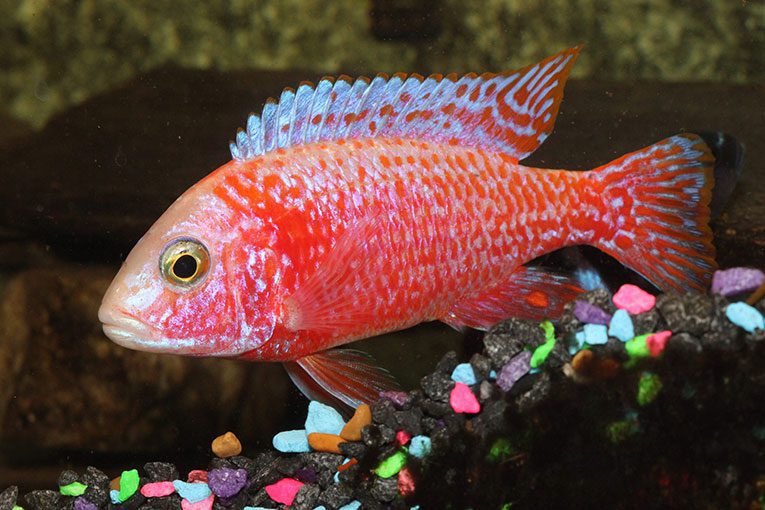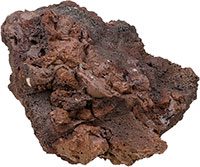Aquarists looking for a colorful and fairly peaceful tank choose peacock cichlids. This freshwater species is vibrantly colored, relatively mellow and easy to maintain. But what do you need for a thriving peacock cichlid tank?
Proper setup can make or break your aquarium. When everything is harmonious, fish keeping isn’t just enjoyable—aquarium ownership offers several proven health benefits.
But if any elements are out of whack, your new pets will be expensive and time-consuming. That’s why we put together this complete guide on how to set up a peacock cichlid tank!
How Large of a Tank for Peacock Cichlids?
The ideal peacock cichlid tank size is at least 55 gallons, like the Aqueon Corner Aquarium. The biggest thing to remember is that this species likes to swim. It’s absolutely crucial to have ample horizontal space for your cichlids.
But the perfect tank size also depends on your tank’s inhabitants. If you’re envisioning a community tank of all male cichlids, you’ll need 110 gallons. Peacock cichlid fish do best with one male and multiple females because they can become territorial and aggressive. So, a bigger tank is necessary for multiple males.
How Do You Set Up a Peacock Cichlid Tank?
You’ll need these items to set up a successful peacock cichlid tank:
- Heater to replicate tropical temperatures
- Sandy substrate for safe digging
- Lights to keep plants healthy
- Filter to control harmful nitrates, ammonia and other chemicals
- Decorations to soothe territorial tendencies
- Feedings twice a day
Every single one of these components serves an important purpose in keeping your new fishy friends happy. Let’s dive in!
Heater
Like most cichlids, peacock cichlids hail from a tropical setting. So, it’s no surprise that they require a warm water temperature (around 79 degrees Fahrenheit). The easiest and safest way to maintain this is with a submersible heater.
Our go-to is the Aqueon 200 watt Pro Aquarium Heater. The built-in temperature dial makes it easy to set. This filter also includes a few helpful safety features, like an auto shut-off to avoid overheating issues.
Best of all, you can use this same heater at a higher wattage if your tank is bigger than 55 gallons.
Sandy Substrate
Peacock cichlids love to dig and root around in their substrate. Gravel isn’t a great choice because the rocks can cause pain or injuries while your fish dig.
So, sandy substrate is the way to go. We love CaribSea Eco-Complete African Cichlid White Sand Substrate in our cichlid tanks. It’s safe and gentle for this inquisitive species.
It also reduces the amount of harmful dirt and bacteria floating in the water, which helps keep your fish healthy, too.
Lights
Lighting your tank offers several benefits. First, the lights will help your plants grow—and they can help keep bacteria levels in balance, too. But they also really bring your tank to life.
Peacock cichlids are famous for their bright and unique coloring. When the light catches their scales, the sight is truly breath-taking.
We swear by the Aqueon Modular 24” LED Aquarium Lighting System for our fish tanks. The price is great, especially for long-lasting LED bulbs. Setup is simple, too. Best of all, this system is modular! If you ever move to a bigger or smaller tank, you can adjust this system however you need.
Filtration
Peacock cichlids need clean, pollutant-free water, just like we need clean air to breathe. This is exactly why aquarium filters are necessary!
We suggest the Fluval 307 Performance Canister Filter. It’s suitable for tanks up to 80 gallons, keeps the water crystal-clear and it’s whisper quiet.
Plants and Decorations
Creating an aquascape to please your peacock cichlids can be tricky. These fish have an instinct to dig up rooted plants. Even worse, cichlids tend to eat the leaves off of nutrient-rich plants! If yours don’t dig up the greenery, there’s still a chance they’ll munch on the leaves.
But in our experience, peacock cichlids don’t like the taste of Anubias or Java Ferns. These two plants are also easy to care for, making them a great low-maintenance choice for any cichlid tank.
You’ll also want to create as many nooks and crannies as possible by placing a wide variety of rocks.
Food
Feeding your peacock cichlids twice a day makes them far less likely to eat the plants. In the wild, these fish dive to the bottom and hunt for food. That’s why sinking food pellets are a favorite for this species.
Our peacock cichlids seem to love Hikari Cichlid Gold Mini Pellets. They’re a great size whether your fish are juveniles or fully grown.
What Do Peacock Cichlids Like in Their Tank?
Peacock cichlids like for their tank to match their natural tropical setting, which requires:
- Driftwood and rocks to match the caves and crevices found in their natural habitats
- Cichlid-proof plants mentioned above
If you want a little more variety in your tank, just consider the timing. Giving your aquarium plants two weeks to take root before adding any fish makes it much harder for your cichlids to rip the plants out and redecorate. This timing gives you quite a few more options for aquarium plants.
Is Sand or Gravel Better for Peacock Cichlids?
As we briefly mentioned above, sand is a better choice than gravel for peacock cichlids. Opting for sand benefits both you and your fish, so we highly recommend sand.
You see, peacock cichlids’ natural tropical habitat includes lots of sand, and their instincts are tuned for finding food in sandy substrate. Gravel as a substrate doesn’t mesh with these instincts—and it can potentially injure your fish.
Peacock cichlids just aren’t built for gravel substrate. Moving those chunkier rocks is much different than sifting through sand.
Picture what it’s like to look through your pantry for food each day. You’re used to the typical weight of things like a bag of chips, a box of rice, etc. Now, imagine you wake up one morning and, shockingly, everything weighs double or triple what it did yesterday.
What are the odds of causing yourself discomfort while moving one of these suddenly heavy items? Pretty high, right?
Putting gravel in your peacock cichlid tank is just like the above example. Doing so can confuse your fish and cause inadvertent injuries.
Plus, as a fish tank owner, it’s just plain easier to keep sand clean versus gravel. Choosing gravel won’t just negatively impact your fish—it’ll sharply increase how much time you have to spend on maintenance each week.
Do Peacock Cichlids Like Salt in Their Water?
Yes, peacock cichlids tend to appreciate a small amount of salt in their water. This may sound counterintuitive since these fish need a freshwater tank, but a bit of salt can make a huge difference.
Salt is commonly used in freshwater aquariums to treat things like bacteria, fungi and parasites. The rule of thumb is to add 1 tbsp of salt for every 3 gallons of water.
And you can benefit from doing so even if your fish seem healthy. Adding this small amount of salt can improve your peacock cichlids’ color, activity level and overall health. The one thing to keep in mind? Any plants you have growing in your tank.
A small amount of salt can be detrimental to your aquarium plants. If your plants’ foliage starts to turn red, it’s a good sign you don’t need any more salt. You may choose to use artificial plants and decorations in your tank, in which case this issue won’t impact your cichlid tank.
You can also purchase this aquatic refractometer by Imagitarium to keep an eye on the salinity level of your tank, which takes out any guesswork.
Do Peacock Cichlids Need Plants?
No, peacock cichlids don’t absolutely need plants—but they will need a substitute if you opt to skip plants in your tank.
You’ll want quite a bit of rockwork to give your peacock cichlids all the nooks, crannies and hiding places they could ever need. Plus, rocks and stones are harder for cichlids to uproot than plants. So, stones and other decorations are often a better choice than plants when it comes to peacock cichlids.
How Many Peacock Cichlids Should Be Kept Together?
Ideally, you’ll want at least three peacock cichlids in the tank together—two females and one male. But you can keep more in the same tank if you keep a ratio of two to four females per male.
All in all, peacock cichlids are docile and peaceful. Females tend to get along quite well with one another. But like we said earlier, placing more than one male in a community tank requires striking a delicate balance.
When the ratio is wrong, male peacock cichlids can become territorial over the entire tank—which causes stress for your other fish.
When it comes to which species make the best peacock cichlid tank mates, consider other less-aggressive cichlid species. Our favorites include Haplochromis, Placidochromis and Copadichromis. These make a great addition to any African peacock cichlid tank since they’re all from the same region in Africa. They have similar dietary, pH and temperature requirements, which makes tank maintenance much easier.
What Temperature Do Peacock Cichlids Like?

Peacock cichlids do best with a temperature between 76 degrees and 82 degrees Fahrenheit since they come from a tropical climate. That’s why the heater we mentioned earlier is 100% necessary for your peacock cichlid tank setup.
More importantly, these fish don’t do well with sudden changes in water temperature. This needs to be monitored carefully—use an aquarium thermometer to help keep tabs on the temperature any time, day or night.
But remember, temperature isn’t the only thing you have to monitor. The ideal pH for convict cichlids is between 7.8 and 8.6.
Other factors like ammonia, nitrates and more can seriously affect the health of your fish. The easiest way to maintain balance is with an all-in-one test kit, like the API Freshwater Aquarium Master Test Kit.
Use these tips to set up a tank that helps your peacock cichlids thrive. Your ultimate goal is replicating their natural environment with warm water, a sandy floor, hearty plants and lots of rocks.










